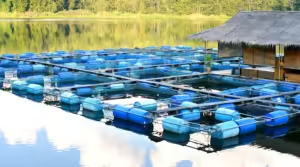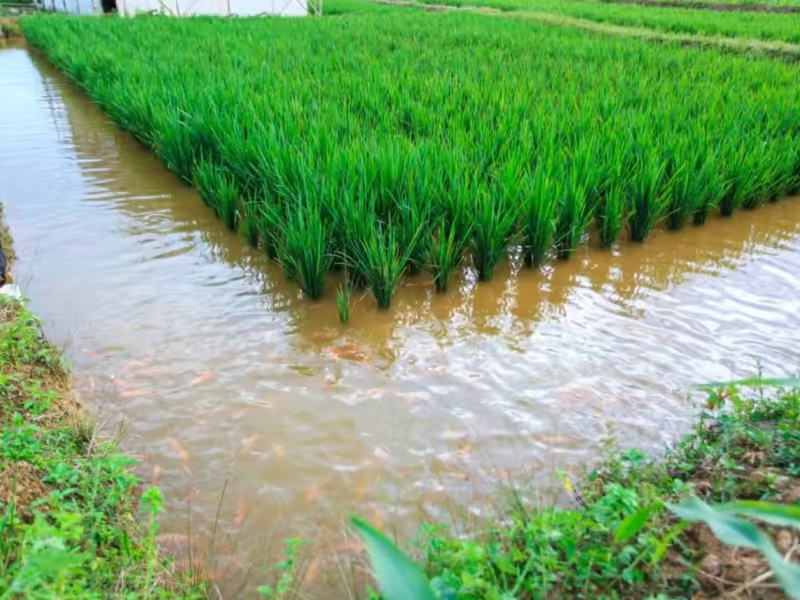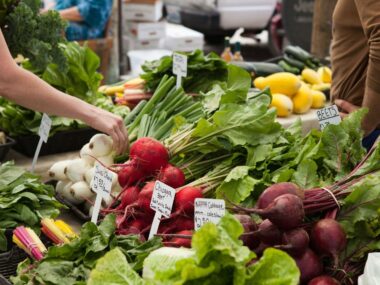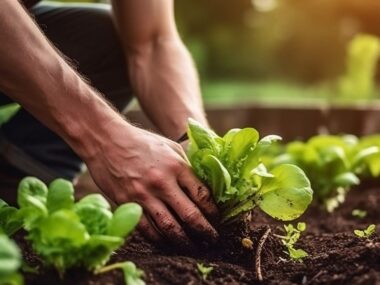Integrated fish farming, also known as aquaponics or integrated aquaculture-agriculture systems, represents a revolutionary approach to farming that combines aquaculture (raising fish) with agriculture (cultivating plants) to create a mutually beneficial and sustainable ecosystem. This method leverages the natural symbiosis between fish and plants to enhance productivity, reduce waste, and promote environmental sustainability. As global populations rise and agricultural pressures increase, integrated fish farming presents an innovative solution for meeting food security needs while minimizing environmental impact.

The Concept of Integrated Fish Farming
Integrated fish farming involves cultivating fish and plants together in a closed-loop system where the waste produced by the fish serves as a nutrient source for the plants. This system typically includes:
- Aquaculture Tanks:
- Fish are raised in tanks or ponds where their waste, rich in ammonia, is excreted into the water.
- Biofilter:
- Beneficial bacteria convert the ammonia from fish waste into nitrates, which are less toxic and more suitable for plant uptake.
- Hydroponic Beds:
- Plants are grown in water or a soilless medium, absorbing the nitrates as nutrients, thus purifying the water before it is recirculated back to the fish tanks.
This symbiotic relationship mimics natural ecosystems and provides a holistic approach to farming that can be implemented in various scales, from backyard systems to commercial operations.
Benefits of Integrated Fish Farming
- Resource Efficiency:
- Integrated fish farming maximizes the use of resources by recycling water and nutrients within the system. This reduces the need for chemical fertilizers and minimizes water waste.
- Sustainability:
- By combining aquaculture and agriculture, integrated systems reduce the environmental footprint of food production. They lower greenhouse gas emissions, decrease water pollution, and promote biodiversity.
- Enhanced Productivity:
- The complementary relationship between fish and plants enhances overall productivity. Fish waste provides essential nutrients for plants, leading to faster and healthier plant growth, while plants help maintain water quality for fish.
- Economic Viability:
- Integrated fish farming can offer higher yields and diversified income streams. Farmers can harvest both fish and crops, potentially increasing profitability and reducing financial risks.
- Food Security:
- These systems can contribute to food security by producing a continuous supply of fresh fish and vegetables. They can be established in various environments, including urban areas, making fresh food accessible to more people.
Implementing Integrated Fish Farming
- System Design and Setup:
- Designing an integrated fish farming system requires careful planning to ensure the balance between fish and plant needs. Key components include fish tanks, biofilters, hydroponic beds, and water pumps for circulation.
- Fish Selection:
- Choosing the right fish species is crucial. Commonly used species include tilapia, catfish, and trout, which are hardy, fast-growing, and adaptable to various conditions.
- Plant Selection:
- Plants that thrive in hydroponic conditions are ideal. Leafy greens, herbs, and certain fruiting plants like tomatoes and peppers are commonly grown in integrated systems.
- Water Management:
- Maintaining water quality is vital for the health of both fish and plants. Regular monitoring of pH, ammonia, nitrate levels, and temperature ensures optimal conditions.
- Nutrient Cycling:
- Efficient nutrient cycling is achieved through biological filtration. Beneficial bacteria play a key role in converting ammonia into nitrates, which are then absorbed by plants.
- Pest and Disease Management:
- Integrated systems can be more resilient to pests and diseases, but regular monitoring and preventive measures are necessary. Natural pest control methods and biological treatments are preferred over chemical pesticides.
Case Studies and Success Stories
- Backyard Aquaponics in Australia:
- A small-scale aquaponics system in a suburban backyard successfully produces enough vegetables and fish to support a family of four. The system includes a 1,000-liter fish tank and several grow beds, demonstrating the feasibility of integrated fish farming in urban environments.
- Eco-Farms in Asia:
- In countries like China and Vietnam, integrated rice-fish farming systems have been practiced for centuries. These systems involve raising fish in flooded rice paddies, where fish waste fertilizes the rice plants, and the rice provides a habitat for the fish. This traditional practice boosts rice yields and provides an additional source of protein.
- Commercial Aquaponics in the United States:
- Large-scale commercial aquaponics farms, such as those in the Midwest, combine fish and vegetable production in greenhouse settings. These farms use advanced technologies to monitor and control environmental conditions, achieving high productivity and year-round harvests.
Challenges and Considerations
- Initial Investment:
- Setting up an integrated fish farming system can require significant initial investment in infrastructure and equipment. However, the long-term benefits and potential returns often justify the costs.
- Technical Knowledge:
- Successful implementation requires a good understanding of both aquaculture and hydroponics. Farmers must be knowledgeable about fish and plant biology, water chemistry, and system management.
- Scale and Scalability:
- While integrated systems can be scaled to various sizes, managing larger systems can be complex. Careful planning and management are necessary to ensure the balance between fish and plant production.
- Regulatory Compliance:
- Farmers must be aware of and comply with local regulations regarding aquaculture and agriculture. This includes water use, waste management, and food safety standards.
- Market Access:
- Access to markets for both fish and produce is essential for profitability. Farmers should identify potential buyers and establish reliable distribution channels.
Future Prospects and Innovations
- Technological Advancements:
- Emerging technologies such as automated monitoring systems, IoT devices, and AI-driven analytics are enhancing the efficiency and productivity of integrated fish farming. These innovations help optimize nutrient cycling, water management, and overall system performance.
- Climate Resilience:
- Integrated fish farming can contribute to climate resilience by providing stable food production systems that are less reliant on external inputs. These systems can adapt to changing environmental conditions, reducing the risk of crop failures.
- Urban Agriculture:
- As urban populations grow, integrated fish farming offers a viable solution for urban agriculture. Rooftop aquaponics systems and vertical farming can provide fresh food in cities, reducing the need for transportation and lowering carbon footprints.
- Educational Opportunities:
- Integrated fish farming presents valuable educational opportunities for schools and community organizations. These systems can be used as teaching tools to promote awareness of sustainable agriculture and environmental stewardship.
- Global Impact:
- On a global scale, integrated fish farming has the potential to address food security challenges, promote sustainable agricultural practices, and support economic development in both developed and developing countries.
Conclusion
Integrated fish farming is a promising approach that combines aquaculture and agriculture to create sustainable, efficient, and productive farming systems. By leveraging the natural symbiosis between fish and plants, these systems offer numerous benefits, including resource efficiency, environmental sustainability, enhanced productivity, economic viability, and improved food security. Despite the challenges, the future of integrated fish farming looks bright, with technological advancements and innovative practices paving the way for widespread adoption. As we strive to meet the growing global demand for food while minimizing environmental impact, integrated fish farming stands out as a beacon of sustainable agriculture.










